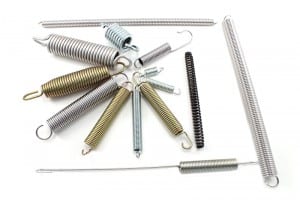When it comes to understanding the difference between compression vs extension springs, look no further than the springs themselves. True, compression and extension springs have certain shared characteristics. For starters, both are easily recognizable by their familiar tightly wound, helical coils. Each is commonly made of spring steel or another non-ferrous metal. When a force is applied to either, each spring will return to its exact original position when that force is removed. This is due to the elastic properties each spring holds, which is a defining characteristic of nearly every spring design.
Beyond these few shared traits, any similarity in design and function between the two springs ends there. In fact, in terms of spring design and function, they are complete opposites and that is why understanding their differences is important—selecting the right spring is essential to meet specific design requirements for any given application.
Compression Springs
 As the name suggests, compression springs provide resistance and absorb force when a load is applied and the spring is compressed. When loaded, the coils of the spring become shorter, holding and storing mechanical energy efficiently until the force is removed, whereupon the stored energy is released and the spring returns to its original position.
As the name suggests, compression springs provide resistance and absorb force when a load is applied and the spring is compressed. When loaded, the coils of the spring become shorter, holding and storing mechanical energy efficiently until the force is removed, whereupon the stored energy is released and the spring returns to its original position.
In fact, a characteristic difference between a compression spring and an extension spring is the visible space between the coils of the latter. In an unloaded state, the spaces between a compression spring’s coil are visible and open. In contrast, an extension spring’s coils are closed and touch each other when unloaded. When a compression spring is loaded the spaces between the coils will compress but never touch, which creates the necessary energy to carry the load. If the coils are in contact with each other then the load is either too heavy, meaning there is a design flaw or, the spring has reached the end of its service life.
The design configurations, the shapes and sizes of compression springs, vary in relation to the application requirements. Straight, conical, convex (barrel-shaped) or concave (hourglass-shaped) are typical compression spring designs. Depending on the application, compression springs can be used as shock absorbers, vibration dampers, as pure energy accumulators, or force generators. They are designed for use in a diverse number of product applications—automobile suspensions, medical equipment and devices such as pacemakers, in hydraulic systems, mattresses and couches, watches, pens, lawn and garden tools and equipment, firearms, industrial machinery and tooling, toys, electronic devices, and much more.
Extension Springs
 As the opposite of a compression spring, an extension spring is designed to resist a pulling force. Its coil is tightly wound together to create initial tension in the coils that store and absorb energy that resists force when it is applied. Thus, they are sometimes referred to as tension springs because energy is created through the tension caused by the tightly wound coils. That tension provides the necessary resistance to counter any pulling force while simultaneously creating the required energy to carry the load when the spring is being pulled or stretched. Extension springs are used for storing potential energy or to create resistance against a directional force when pulled or stretched.
As the opposite of a compression spring, an extension spring is designed to resist a pulling force. Its coil is tightly wound together to create initial tension in the coils that store and absorb energy that resists force when it is applied. Thus, they are sometimes referred to as tension springs because energy is created through the tension caused by the tightly wound coils. That tension provides the necessary resistance to counter any pulling force while simultaneously creating the required energy to carry the load when the spring is being pulled or stretched. Extension springs are used for storing potential energy or to create resistance against a directional force when pulled or stretched.
An extension spring is configured with loops or hooks at each end that are then attached to two opposite components. The purpose here is to provide an extended force when the spring is pulled apart from its original position. When a pulling force is applied to stretch the components apart, the tensile strength of this spring brings them back to its original point.
The initial tension preloaded into the coils is an important design function that can be calculated to meet specific load requirements, such as required for aircraft landing gears or stretchers, surgical lights, instruments and other in medical equipment and devices. Extension springs hold the drum of washing machines in place. They are essential components in farm machines and equipment as large as combine harvesters, plows and the tractors that pull them. Extension springs are also used to open and close a car’s glove box and the hoods of heavy trucks. They are integral component parts for baby carriages, toys, trampolines, vice grips, electronic devices, fence posts, garage doors and much more.
Importance of Selecting the Right Spring
It may be argued that there is no other mechanical component more indispensable than the spring. Nonetheless, selecting the right spring is necessary to ensure that the design requirements for applications are met. Compression and extension springs are two common spring designs that serve different application requirements in products used in numerous industries—manufacturing, agriculture, transportation, durable goods, construction, medical, petrochemical, and aeronautical to name a few. For more information, contact James Spring & Wire Company, an original equipment manufacturer (OEMs) of custom compression and extension springs.

